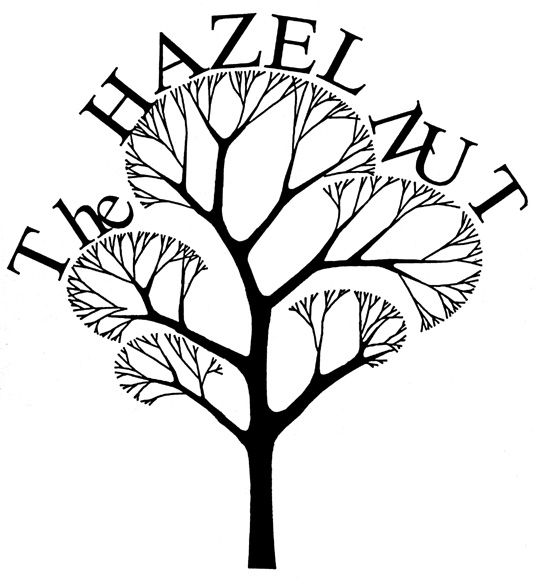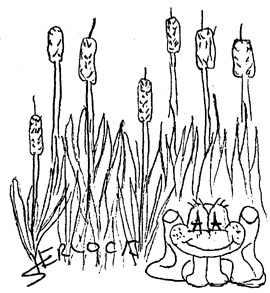

In This Issue:
From Further Out - Muirghein ó Dhún
Aonghasa (Linda Kerr)
From Brighid's Hearth: Arthritis - Freya
The Huna System of Magic and Prayer - Rhianon
How to Pray -Muirghein ó Dhún Aonghasa (Linda
Kerr)
From Samhain to Halloween - Muirghein ó
Dhún Aonghasa (Linda Kerr)
Poetry: The Earth is Round - Shadowcat
A Twentieth Century Divination - Mirhanda Spellesinger
Spider Woman and the Moon - Stormy
Folklore & Practical Uses: Ivy - Muirghein ó
Dhún Aonghasa (Linda Kerr)
Lunar Energies & Esoterica: Ivy - Freya and
Epona
Folklore & Practical Uses: Reed - Muirghein ó
Dhún Aonghasa (Linda Kerr)
Lunar Energies & Esoterica: Reed - Imré and
Muirghein ó Dhún Aonghasa (Linda Kerr)
Runes: What Are Runes? - Stormy
Bubbles From the Cauldron - book reviews, etc.
Staff:
Publisher: The Garden Club
Editor: Imré Rainey
Layout Editor: Muirghein ó Dhún Aonghasa (Linda Kerr)
Contributors: Epona (poetry), Freya, Mirhanda Spellesinger, Rhianon, Shadowcat (poetry),
Sherlock (artwork), Stormy.
Cover graphic by Muirghein
THE HAZEL NUT, Volume I, Issue 5, Copyright © 1993 The Garden
Club. October/November 1993, Ivy/Reed Moon. THE HAZEL NUT is published
monthly by
The Garden Club.
FROM BRIGHID'S HEARTH: ARTHRITIS
by Freya
Sources:
(1) Mindell, Earl. Herb Bible. 1992. Simon & Schuster, NY, pg. 222-223.
(2) Tierra, Michael. The Way of Herbs. 1980. First Washington Square Press,
NY, pg. 225-226.
(3) Haas, Elson M. Staying Healthy With the Seasons. 1981. Celestial
Arts, CA, pg. 55.
(4) lbid, pg. 55.
(5) Lust, John. The Herb Book. 1974. Bantam Books, NY, pg. 457.
(6) Ibid, pg. 457.
THE HUNA SYSTEM OF MAGIC & PRAYER
by Rhianon
by Muirghein ó Dhún Aonghasa (Linda Kerr)
Sources:
(1) Long, Max Freedom. The Secret Science Behind Miracles, 1948, and The Secret Science At Work, 1953. DeVorss &Co., Publishers, Marina del Rey, CA.
by Muirghein ó Dhún Aonghasa (Linda Kerr)
The Gaelic Celts
The Middle Ages
Halloween Fires
Guising
Divinations
Superstitions

Bibliography:
I am the Mother.
I live I breathe.
I gave you life,
none other.
My seas, my blood
that fills your veins.
Mine the fruit that
filled your bellies.
Mine the Stag that
fed your brother.
You flow with my Moon Sister,
My tides in your ocean
guide me to your lover.
And mine the Earth,
that will hold you one day
like a child in the womb.
As I bring you back to
Your Mother.

A TWENTIETH CENTURY DIVINATION
by Mirhanda Spellesinger

Source:
(1) Cunningham, Scott, The Art of Divination. 1993. The Crossing Press, Freedom, CA.
by Stormy
Spider Woman walks the night sky,
Every night she crawls on by,
She hasn't wings, she doesn't fly,
Suspended on a thread in the sky.
She walks a-stepping on each star,
Around the North, East, South and West
She is seen by many a far
Doing what she always does best.
She takes the silver-golden thread
Starts weaving on her magic loom,
High in the heavens over head--
She begins weaving a new moon!
Beyond the heavens where birds fly,
There hangs a sliver in the sky,
Sweetly smiling at all below
Adding more thread as she goes.
Fuller the moon grows everyday,
Pregnant and round along the way--
With moonbeams gently flowing,
The luminous circle glowing.
High in the heavens overhead,
Spider Woman looks at the moon
Collects the silver-golden thread,
Unraveling that thread so soon.
Each and every single night
The Moon is shrinking out of sight
Onto a ball of silver-gold
So next month's story can unfold.
FOLKLORE & PRACTICAL USES: IVY
Hedera helix Linn. - English Ivy. Temperate zones of Europe and Asia, and also
introduced into the U.S.
Parthenocissus quinquefolia - Virginia Creeper, American Ivy. Found in almost all
parts of the U.S. Introduced into Europe from Canada.
Description
History and Uses
Medicinal
Folklore
Notes:
(1) Grieve, Mrs. M. A Modern Herbal (2 volumes). 1931. Dover Publications, Inc.,
New York, NY, pg. 440.
(2) Grieve, pg. 441, quoting from Professor Henslow, Floral Rambles in Highways and
Byways.
(3) Grieve, pg. 441.
(4) Ibid, pg. 840.
(5) Ibid, pg. 840.
(6) Ibid, pg. 441.
(7) Ibid, pg. 441.
(8) Culpepper, Nicholas. Culpepper's Complete Herbal. W. Foulsham & Co., Ltd.,
London (originally written in 17th century), pg. 201.
(9) Ibid, pg. 442.
(10) Lust, John. The Herb Book. 1974. Bantam Books, New York, NY, pg. 183.
(11) Ibid, pg. 97; Hutchens, Alma R. Indian Herbology of North America. 1973.
Shambhala Publications, Boston, MA, pg. 165.
(12) NOTE: Culpepper's uses for English ivy are similar to Grieve's uses for American ivy, and
her description of American ivy's properties are very different from my other, more modern,
references. I think she may have begun talking about American ivy, but then gone off on a
tangent with the true (English) ivy. At any rate, when looking for practical medicinal uses,
always refer to the more modern text, as the old herbalists did not seem to hesitate to use
poisonous plants to achieve their ends.
(13) Grieve, pg. 840.
(14) Ibid, pg. 840-841.
(15) Ibid, pg. 441.
(16) Hutchens, pg. 165, quoting from Meyers, Joseph E. The Herbalist. 1939.
Published by J.E. Meyers, USA.
(17) Grieve, pg. 441.
(18) Ibid, pg. 441.
(19) Grigson, Geoffrey. The Englishman's Flora. 1955. Phoenix House LTD, London,
England, pg. 116.
(20) Grieve, pg. 441.
(21) For more info, see Folklore & Practical Uses: Holly, Issue #3, July 1993.
(22) Grigson, pg. 207.
(23) Ibid, pg. 116.
LUNAR ENERGIES & ESOTERICA: IVY
by Freya and Epona
From whenth, springs the whitened roe?
In what moon a-hunting stag will you go?
For your return from what you see
I send silver branches of an apple tree.
FOLKLORE & PRACTICAL USES: REED
by Muirghein ó Dhún Aonghasa (Linda Kerr)
Cytisus scoparius - Broom. Indigenous to England, grows wild all over temperate
Europe and northern Asia, on sandy pastures and heaths. Sparingly naturalized in sandy
soil in North America.
Phragmites communis - Reed grass. Tall wetland grass found around margins of
streams
and in wet lowlands.
Typha latifolia - Broad leaf cattail. Worldwide range. Common to North
America.
T. angustifolia - Narrow leaf cattail. Worldwide range. Common to North
America.
Description
History & Uses
Folklore
Medicinal
Other Reed-Like Plants
Cattail Pastries:


Notes:
1 Grieve, Mrs. M. A Modern Herbal (2 volumes). 1931. Dover Publications, Inc., New
York,
NY. pg. 124-125.
2 Ibid, pg. 125.
3 Ibid, pg. 125.
4 Ibid, pg. 126.
5 Ibid, pg. 127.
6 Ibid, pg. 125.
7 Ibid, pg. 125.
8 Ibid, pg. 126.
9 Grigson, Geoffrey. The Englishman's Flora. 1955. Phoenix House LTD, London,
England,
pg. 128.
10 Ibid, pg. 129.
11 Grieve, pg. 124.
12 Ibid, pg. 127.
13 Ibid, pg. 127.
14 Rodale's Illustrated Encyclopedia of Herbs. Edited by Claire Kowalchik and
William H.
Hylton. 1987. Rodale Press, Emmaus, PA, pg. 55.
15 Lust, John. The Herb Book. 1974. Bantam Books, New York, NY, pg. 349-350.
16 Grieve, pg. 127.
17 Rodale's, pg. 55.
18 Meuninck, Jim. Edible Wild Plants and Useful Herbs: The Basic Essentials of.
1988. ICS
Books, Inc., Merrillville, IN, pg. 4.
19 Ibid, pg. 1.
20 Ibid, pg. 1.
21 Ibid, pg. 2.
22 Harris, Ben Charles. Eat the Weeds. 1961. Keats Publishing, Inc., New Caanan,
CN, pg.
103.
23 Hunt, David (ed.). Native Indian Wild Game, Fish & Wild Foods Cookbook.
1992. Fox
Chapel Publishing Co., Lancaster, PA, pg. 208.
24 Meuninck, pg. 2.
25 Harris, pg. 103.
26 Meuninck, pg. 2.
27 Ibid, pg. 2.
28 Harris, pg. 105.
29 Meuninck, pg. 2.
LUNAR ENERGIES & ESOTERICA: REED
by Imré and Muirghein ó Dhún Aonghasa (Linda Kerr)
Netting the roebuck of my raveling mind,
Around the twice-squared circle I run...
...To stop and suddenly See...
To and fro
The Spider weaves;
The mind in lunar light:
Perfect mirror...
To and fro
The Spider weaves,
But She knows Her nets
Are made for food and progeny.
And...
How knows the Spider
Whither Her place to Spin?
She ceases Her netting to and fro
And flings Herself
Between the net just passed
And the net that's yet to be,
Flowing on Her silken cord,
Riding through Infinity.
And, then...
Once more,
To and from,
She weaves;
Once more She goes,
Remembering.
0 clinging vine,
Wrapping around the reedy stem.
0 grasping me,
Clinging to a core of Nothingness.
Through the very hollow of me
Is a channel of Life's flowing.
But a reed which never dies
Never sings...
And the reed, which sings with 'human' sounds,
Is still a reed,
With Hollow Core;
As is the dying reed,
Growing its song along restless shores.
The hollowness, the hallowedness,
Is there in life and death.
Just know:
The Flowing Through of Life
Is not changed
By clinging.
Only difference in the music,
The musing,
The reed may have
By its special form.
...The rest is Life's.
These are the runes that cannot be reversed:
The runes that have reversed positions are:*
*Reversed positions have the opposite meaning of meaning above.
Notes:
(1) Dolphin, Deon. Runic Magic. 1987. Newcastle Publishing Co., Inc., North
Hollywood, CA, pg. 28.
(2) Peschel, Lisa. A Practical Guide To the Runes: Their Uses In Divination and
Magick. 1991. Llewellyn Publications, St. Paul, MN, pg. 30-33.
(3) Ibid.
(4) Mountainwater, Shekhinah. Ariadne's Thread: A Workbook.of Goddess Magic.
1991. The Crossing Press, Freedom, CA, pg. 218.
(5) Gadon, Elinor W. The Once and Future Goddess Magic. 1989. Harper & Row,
Publishers, San Francisco, CA, pg, 111-114.
(6) Willis, Tony. The Runic Workbook: Understanding and Using the Power of Runes.
1990. Sterling Publishing Co., Inc., New York, NY, pg. 30.
Stormy (Carol Thompson) lives in Auburn, AL with her husband Don and three daughters. Her interests are: esoteric study of runes; Wicca; and women's mythology. She is currently working on a book about runes.
The Art of Divination, by Scott Cunningham. 1993. The Crossing Press, Freedom,
CA. Softcover, $12.95.
Wheel of the Year: Living the Magical Life, by Pauline Campanelli. 1990.
Llewellyn Pulbications, St. Paul, MN. Softcover, $9.95.